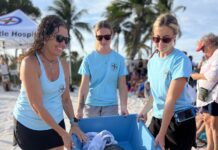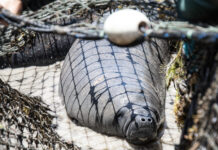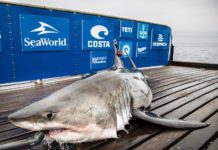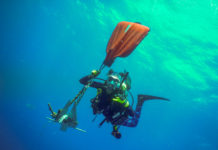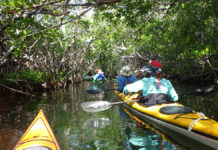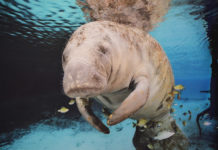
Anglers need to make a plan for any hope of success landing a bonefish, permit and tarpon on same day
(Editor’s Note: Author Bill Horn is far too modest to mention it, so I will: he has three grand slams. He knows of what he speaks.)
It’s Grand Slam season. Not the bases loaded home run slam but something more difficult: scoring a bonefish, permit and tarpon in a single day on the flats. Any angler can be proud of this achievement; among fly fishers it’s the holy grail made exceptionally difficult by the permit’s notorious unwillingness to eat an artificial fly. July, August and September are prime time to pursue the slam because all of the Big Three fish are available. Resident tarpon, mostly smaller fish, can often be found in the early morning. Bonefish respond to building tides to use the flats and permit like the bigger tides too — and don’t seem to mind 90 degree summer waters.
In contrast, during the spring tarpon migration permit are offshore spawning and generally not found on the flats. During the late fall, the tarpon have largely disappeared and in the winter weak tides, and cold fronts, make it hard to find willing bonefish and permit up on the flats. The stars align in the summer to give anglers a shot at all three.
A good game plan is needed to get the slam. Tarpon are usually the first target. As reported in last month’s column, the resident fish roll frequently on calm mornings and can be located before the sun gets high to enough to actually see into the water. Shrimp, shrimp artificials or shrimp flies can all be effective under these conditions. Catching the tarpon quickly and turning attention to the other two species is a prerequisite for a slam. In fact, it can take real discipline to leave a pod of rolling, eating tarpon – after landing one – to chase the wary bones and finicky permit. But no one said a slam would be easy.
Bonefish are usually target No. 2. They too like the post-dawn low light and will feed actively before the waters get too warm. In fact, bonies don’t like water temps north of 85 and will vamoose for cooler depths by mid-morning on a sizzling summer day. With bonefish numbers down, and apparently just starting to recover from the 2010 record cold snap, finding and catching this species might be the hardest part of a slam. Two years ago, Marathon Capt. Albert Ponzoa and I had a fly caught tarpon and permit on board by 10 a.m. and were sure a slam was almost money in the bank. We needed to find only one willing bone to close the deal. Five hours and many flats later we hadn’t seen a single one – sic transit gloria! (Thus passes the glory!) When you can find the bonefish, and get a good shot, you’ve got to make it count and catch the fish. Frustrated tales of “two-thirds slams” are all too common.
Traditionally, though the permit is the big obstacle for slam chasers. It is by far the most difficult of the big three to catch on either bait, artificial or fly. Live crabs the size of an old 50 cent piece are the choice of those actually wanting to catch a perm. Fly guys have concocted all kinds of fake little crabs that permit laugh at … but eat just often enough to keep you trying. Since perms tolerate warm, if not hot, water, they can be targeted after its too bright and hot for tarpon and bonefish. The higher sun helps spot the elusive silver sided fish and frequently all you see is a disembodied black sickle tail sliding through the water – the remainder of the fish is invisible. One shot, or cast, is par for the course and the crab or fly must be landed on a “dinner plate” only a foot or two off the fish’s nose. The strategy is to get a reaction bite – a reflexive grab before the permit can study things. When they take a hard look with their big eyes, the next thing you see is a big wake as the spooked fish powers off the flat.
Once in a rare while, the stars align and the permit gets hooked. An unrelenting tenacious battle follows requiring great patience by the angler. The typical 10- to 15-pound flats permit will be brought near the boat half a dozen times and half a dozen times it will take off running. Efforts to prematurely stop the fish yield broken lines or pulled hooks – and lots of anxiety.
If you want a challenge, head out in pursuit of the Grand Slam. It’s never easy but happens often enough to be tempting.
And speaking of tempting challenges, applications are now being accepted for the 54th Annual Marathon International Bonefish Tournament – the oldest in the Keys. Individuals and teams, guided and self-guided, will bait fish, spin fish, and fly fish Sept. 20–22 in pursuit of a welter of prizes. For information please contact Barbara at 305-304-8682 or Laural at 305-385-1554.
Hope to see you there.
Marathon resident Bill Horn is a veteran Keys’ flats angler, a former Assistant Secretary of the Interior for Fish, Wildlife, and Parks under President Reagan, and author of “Seasons on the Flats: An Angler’s Year in the Florida Keys.” For more information see his website www.seasonsontheflats.com or contact him at bhorn@seasonsontheflats.com.

















